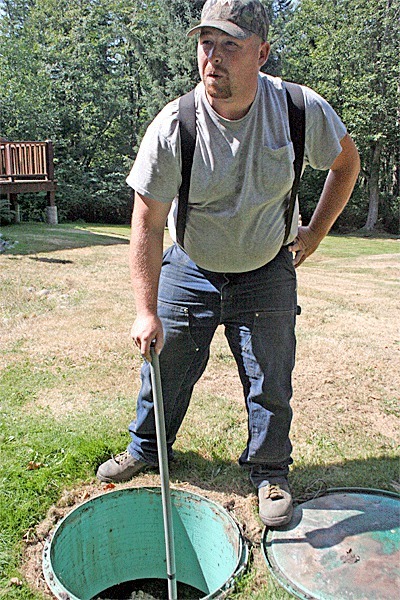Mark Lenocker pulled the first of three lids off a septic mound system at a North Whidbey home Wednesday afternoon and immediately knew something was wrong. A solid mass of shiny-brown sewage was at the top, nearly overflowing from the underground tank.
At the next lid, it was clear that effluent had been escaping from the septic tank for quite some time onto the lawn where the owner’s dog plays.
“That’s not good,” Lenocker said to his boss, Bruce Silvia of Oak Harbor’s Silvia Septic Service.
The men were at the home to do an annual inspection of the mound system, as required by Island County code. They discovered that the floats weren’t working properly, which stopped the pumps and allowed sewage to overfill the tanks.
The fix was relatively simple, Silvia said, but it’s clear that the inspection prevented much more serious problems. Unchecked, the build-up of sewage could have caused the system to fail, which would cost an estimated $18,000 to repair. And the sewage in the lawn poses a risk to human health and the environment.
Commercial septic pumpers and inspectors have an obvious bias, but by and large they seem supportive of the county’s controversial mandatory septic program. County health department officials reported good news about the program at a Board of Health meeting last week, but obvious challenges remain.
The deadline for all Island County residents with septic tanks to get them inspected has now passed, but only about 15 percent of homeowners on septic systems have complied with the requirement. It’s clearly not a popular program. Residents crowded into meeting last year and sent letters to the county venting their anger at the requirements.
Perhaps the biggest complaint was about the $62 fee the county charges at the time inspections reports are filed. The county commissioners had promised that the fee was temporary, but it remains.
The county’s program implements the state requirement that residents have conventional, gravity septic systems inspected every three years, and more complex systems — like mounds — inspected annually.
“I think it’s a good idea, but it may need to be refined a little,” Silvia said, adding that the fee should be modified. “We’re on an island and it all ends up somewhere. We don’t want it to get into the shellfish or go into ditches or lawns where children play.”
Aaron Henderson, the county’s environmental health director, said commercial septic inspectors on the island tell him that they find problems with about half of the septic systems they inspect.
Both Silvia and Ron Brown of Brown Bear Septic Pumping on South Whidbey agree.
“Quite a few systems have minor problems. It’s usually something that can be fixed,” Brown said, but added that his company has also discovered systems that have failed.
Silvia said the average cost of inspecting a simple gravity system is around $150. Yet he said it would be less if more people complied with the county rules, so that he could do inspections a neighborhood at a time.
Last week, health department staff members told the county Board of Health that the controversial septic program is pretty successful, compared to other counties.
“Every county has been trying to figure it out and are struggling…” Joe Laxson, environmental health specialist, said. “I think we’ve gotten better results than other counties. I think we have a better balance.”
Keith Higman, director of the health department, gave a brief history of the rules regarding septic tank inspections. He explained that the state left counties with little leeway in how the program is implemented. Basically, the counties can only decide who can inspect the systems and how the county’s programs are funded.
Laxson gave a Powerpoint presentation that compared Island County’s program with other counties’ programs. Island County is only one of eight counties that allows homeowners to inspect their own septic tanks, unless it’s a complex system. The county’s septic university, Homeowner Septic Training or HOST, has graduated more than 5,000 people in three years.
Island County Public Health is moving forward slowly with compliance and enforcement efforts. In the first such action, staff members recently sent out a “reminder” letter to residents in the South Holmes Harbor Shellfish District who haven’t filed a septic inspection report.
Henderson said he wants to give all the people on the long waiting list for HOST to get a chance to take a class and do their own inspection before the county gets serious with enforcement.
Henderson said he hopes to get the 101 septic inspection class online this fall so that people can go through it at home. They still would have to take the 201 class, but it would hasten the process.
Counties in the state fund the septic system programs from at least a couple of sources, but it appears that Island County’s much-maligned $62 fee, due at the filing of the inspection report, is one of the most costly in the state. King County, for example, charges a $100 fee, but that’s only due at the time of sale. Skagit County funds the program through a clean water utility tax, which is what officials in Island County are considering.
Higman has been opposed to the $62 fee, arguing that it would be a disincentive for people to get their septic tanks inspected. Higman estimated low initial compliance with the program among the estimated 26,000 septic tank owners in the county, so the fee had to be at a level to make up for all those who won’t pay.
The commissioners are moving forward with a clean water utility tax in a phased approach. They have discussed creating a per-parcel fee to pay for the $200,000-a-year septic program, a hydrogeologist, surface water monitoring, salmon recovery and several other water-related projects. If it’s adopted, the $62 septic fee would go away, plus the tax could free up much-needed current expense funds.



